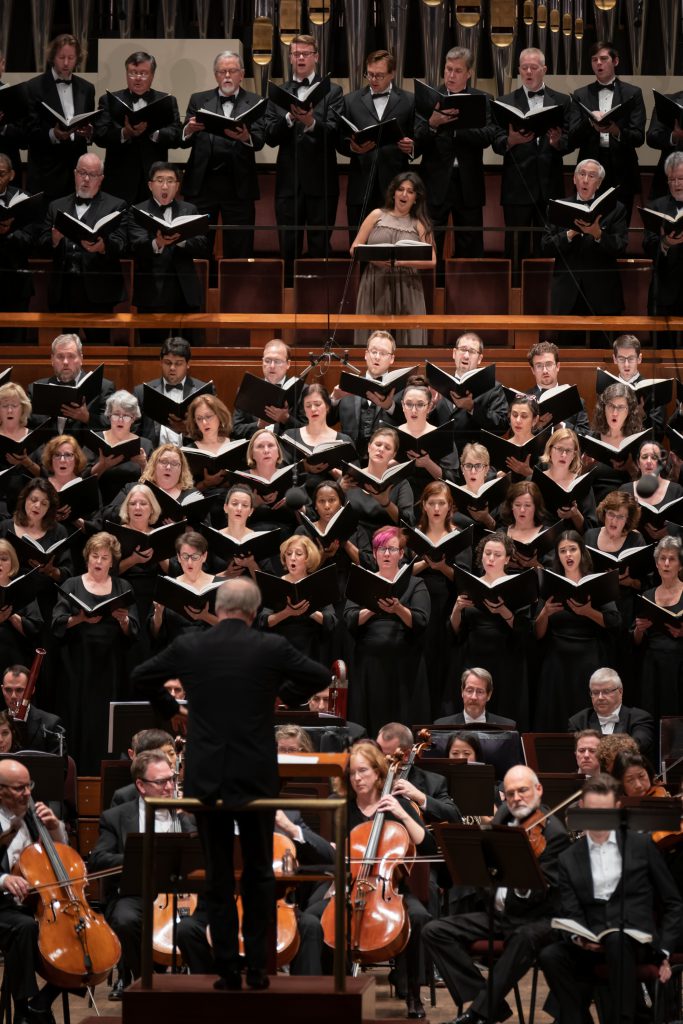Noseda leads NSO forces in an intense and moving “War Requiem”

Gianandrea Noseda conducted the National Symphony Orchestra and Choral Arts Society of Washington in Britten’s “War Requiem” Thursday night at the Kennedy Center. Photo: Scott Suchman
Benjamin Britten’s War Requiem is a work of contradictions. It not only mourns the dead killed in war, it poses uncomfortable questions about the part we may have played in their deaths.
The poised, intense performance led by Gianandrea Noseda Thursday night with the National Symphony Orchestra, two choruses, and three soloists, inspired a storm of feelings ranging from regret and bitterness to rage and horror.
Commissioned for the rededication of Coventry Cathedral in 1962, the War Requiem is at least three different pieces welded together. The first is a liturgical work, the Latin texts of the Catholic Requiem chanted by ghostly chorus and operatic soprano; the second, a treble choir singing Anglican church anthems off in the distance; finally, the tenor and baritone soloists perform chamber opera solo pieces to the poetry of Wilfred Owen, himself shot and killed just a week before the Armistice ending World War I, which we are celebrating this month.
The Choral Arts Society of Washington, meticulously prepared by Scott Tucker, captured the many contrasting qualities of this music. Whispered phrases opened the piece over the brooding lines of the orchestra, with the predominant interval that runs through the score, an unsettled tritone, resolving at the two main climaxes of the evening by melting into a major chord.
Noseda’s confident, frenetic gestures gave impetus to the lopsided dance of the terrifying “Dies irae” movement, the frightful trumpet summoning all the living and the dead to the throne of judgment. The women of the chorus outshone the men, with an especially warm, vibrant tone from the alto section in the “Recordare” movement. Overall the choral contributions were secure and powerful, particularly in the swirling maelstrom at the end of the “Libera me” movement, with the different sections howling out one by one. (Sadly, Noseda left out the optional part for full organ in this movement.)
Seated among the chorister seats above the stage, soprano Karina Flores presided over this liturgical part of the work with imperious authority. In a thick, viscous tone she flung her high notes into space with force and accuracy, perfectly negotiating the plangent leaps of the “Lacrimosa” section. The more exposed moments of the “Benedictus,” for example, were luscious in their softness, if not as confident.
The treble voices of the Children’s Chorus of Washington, now under the leadership of Margaret Nomura Clark, provided the evening’s most moving choral moments. Placed just off the right side of the stage and heard through an open door to the accompaniment of a chamber organ, the thirty-some child choristers evoked an air of innocence with their first entrance on the psalm section of the introit. Britten twists this sound into a mocking laugh in the “Hostias” movement, a schoolyard taunt in response to Owen’s poem that ends with Abraham sacrificing Isaac after all, and half of Europe with him.
For the piece to work optimally, the last element requires excellent tenor and bass soloists. Noseda turned to Ian Bostridge and Matthias Goerne, both known for their achievements in solo song as well as opera. Bostridge, with his hooty tenor and impeccable English diction, incarnated the boyish sweetness of Owen’s poetry. The “Move him into the sun” movement was especially haunting, accompanied by mere tremors of strings and winds in the chamber orchestra of NSO principal musicians, set off to the right side.
For the anger and bitterness, Goerne’s more gravelly baritone was equally ideal, molasses-smooth in “Bugles sang” and a roaring cataract of sound in the horrifying “Be slowly lifted up, thou long black arm,” an ode to a piece of artillery, both savior and destroyer. Rare moments of disjunction came mainly in these solo pieces with the chamber orchestra, set at a greater distance from Noseda and at an awkward angle when he turned to look at the score in front of him.
The program will be repeated 8 p.m. Saturday. kennedy-center.org; 202-467-4600




Posted Dec 02, 2018 at 8:05 pm by Matt
I saw the performance last night. It was exquisite,haunting, powerful, disturbing, beautiful, indelible.